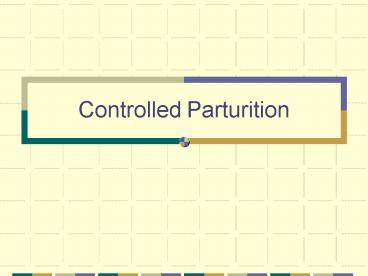Controlled Parturition PowerPoint PPT Presentation
1 / 18
Title: Controlled Parturition
1
Controlled Parturition
2
Controlled Parturition
- Synthetic corticoids
- Dexamethasone 20 mg
- Flumathasone 7.5 mg
- Cows responding can be expected to calve between
34-60 hours post-injection (505 hours).
3
- Effects on cow
- Normal birth slight increase in difficulty due
to lack of complete dilatation and relaxation of
soft tissue. - Retention of placenta is very common.
- Popular form of treatment pen- strept.
- No detrimental effect on milk production
- Effects on calf
- Reduction in birth weight
4
- Applications are a management tool
- Control time of calving
- Heifer bred to known large offspring producing
bulls - Termination of calving period in naturally mated
herds - Other uses
- Excessive udder edemas- chronic prolapse of
vagina- abnormalities of pregnancy
5
Parturition
- The physiologic process by which the pregnant
uterus delivers the fetus and placenta from the
maternal organism.
6
Signs of Parturition (physiological and
behavioral)
- 1. Changes in the pelvic ligaments
- -Soften and relax
- 2. Enlargement and edema of the vulva
7
- 3. Mammary activity
- -obvious enlargement of the mammary gland
- -teats become swollen and secretions from the
teat orifice may be observed - -Mare colostrum oozes from the teat orifice
forming a bead of waxing material at the site of
each teat orifice - 4. Nest building
- -a feature often observed in polytoccous
animals behavior may be hindered in intensive
management systems
8
Initiation of Parturition
- Triggered by the fetus involving a complex
interaction between endocrine, neural and
mechanical factors (theories on initiation) - SOW
- corticosteroids- concentrations increase within
24 hours of parturition and decrease during early
lactation - progesterone- levels decline during the last
days of pregnancy and drop abruptly by day 1
postpartum
9
Some Theories On The Initiation of Parturition
- Theory
- Fall in progesterone concentration
- A rise in estrogen concentration
- Possible Mechanism(s)
- Blocks myometrial contractions during pregnancy
near term the blocking action of progesterone
decreases - Overcomes the progesterone block myometrial
contractility and/or increases spontaneous
myometrial contractillity
10
Some Theories on the Initiation of Parturition
- Theory
- Increase in uterine volume
- Release of oxytocin
- Possible Mechanism(s)
- Overcomes the effect of progesterone block of
myometrial contractility - Leads to contractions in an estrogen-sensitized
myometrium
11
Some Theories on the Initiation of Parturition
- Theory
- Release of prostaglandins (PGF2)
- Activation of fetal hypothalo-pituitary
- -adrenal axis
- Possible Mechanism(s)
- Leads to contractions in an estrogen-sensitized
myometrium - Fetal corticosteroids cause a fall in
progesterone, a rise in estrogen and a release of
PGF2 these events lead to myometrial
contractility
12
Sow
- prostaglandin PGF2- continual rise until
parturition and then declining to bacal levels - estrone- increases to peak levels until day 2
pre-partum and then falls to basal levels after
delivery - estradiol- follows same pattern as estrone
13
Sow
- The rise in estrone and estradiol is associated
with fetal maturity and is primarily of placental
origin - The number of fetal adrenal cortical cells
increase rapidly from day 105 to 113 of
pregnancy- increasing cortisol secretion
14
- Cow and other species are similar to those seen
in the sow - Note
- PGF2? in the pig, cattle, and goats has a
luteolytic (CL dependent) responsibility as well
as an oxytocic effect in that it causes
myometrial contractions. Whereas in the sheep
(placenta dependent) regression of the CL does
not necessarily need to precede parturition, so
primary effect of PGF2? is on the myometrium of
the uterus.
15
- Fetal cortisol activates 17a- hydroxylase, an
enzyme that causes conversion of progesterone to
estrogen. This elevation is estrogen stimulates
release of PGF2? and development of oxytocin
receptors
16
(No Transcript)
17
Mechanisms of Parturition
- Myometrial contractions
- Estrogen and progesterone influence motility
through the release of PGF2? - PGF2? interacts with smooth muscle adenyl cyclase
causing a decrease in cAMP levels which in turn
causes contractions - Dilation of cervix
- 1. May be influenced by estrogen and PGF2?
18
- Prostaglandins
- Specifically, PGF2? is the key player involved in
the events determining the time of parturition in
all species regardless of whether maintenance of
pregnancy of CL-dependent or placental-dependent - -The major site of PGF2? synthesis seems to be
from the endometrium - -fetus determines the day maternal determines
the hour of the day of parturition

